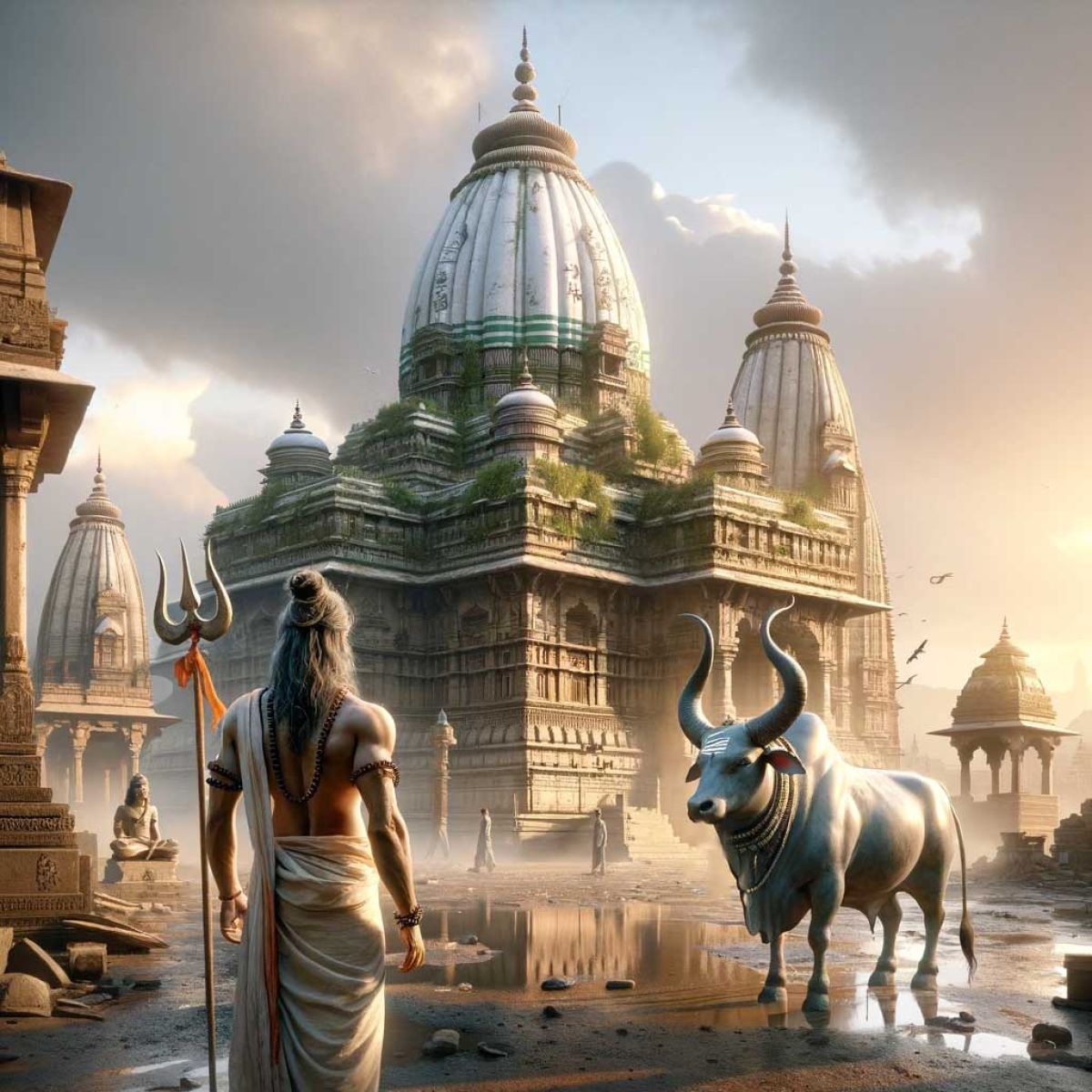More Coverage
Twitter Coverage
JOIN SATYAAGRAH SOCIAL MEDIA
"ॐ त्र्यम्बकं यजामहे सुगन्धिं पुष्टिवर्धनम्": In a Historic win for Hindus, Allahabad HC upholds right to worship at Gyanvapi, dismisses all Muslim petitions, Court orders swift 6-month decision, ASI can survey any part of plot number 9130 (Gyanvapi site)

In a landmark judgment celebrated as a significant victory for the Hindu community, the Allahabad High Court has delivered a crucial verdict concerning the Gyanvapi land dispute. The court's ruling emphatically states, "Hindus seeking the right to worship on Gyanvapi land, restoration of the temple not barred by Places of Worship Act." This decision marks a pivotal moment, as it upholds the rights of Hindu worshippers and deity in a case that has been a focal point of religious and cultural significance.
|
The Allahabad High Court's judgment addresses the long-standing dispute over the Gyanvapi land, a site of deep historical and religious importance. The court has ruled that the civil suits filed by Hindu worshippers and deity, which demand the right to worship on the disputed Gyanvapi land and seek the restoration of the temple, do not conflict with the provisions of the Places of Worship Act 1991. This Act, which generally prohibits the conversion of any place of worship, does not apply in this particular case, according to the court’s interpretation.
This ruling represents not just a legal triumph but a reaffirmation of the Hindu community's right to worship and preserve their religious heritage. The significance of this decision cannot be overstated, as it paves the way for the potential restoration of the temple, a symbol of great reverence and devotion for many Hindus.
Simultaneously, the Allahabad High Court has dismissed all five petitions filed by the Masjid Committee. These petitions challenged the suits brought by Hindu worshippers and the deity in the context of the Kashi Vishwanath Temple-Gyanvapi land title dispute. The dismissal of these petitions by the court further strengthens the position of the Hindu plaintiffs in this case.
The ruling by the Allahabad High Court is being hailed as a monumental and celebratory win for Hindus. It is seen as an affirmation of their religious rights and a step towards the preservation and restoration of their cultural and religious landmarks. The decision resonates deeply within the Hindu community, symbolizing a triumph of faith and the legal recognition of their historical claims.
|
The recent ruling by the Allahabad High Court, seen as a monumental victory for the Hindu community, was delivered by Justice Rohit Ranjan Agarwal. This decision, which was eagerly anticipated since being reserved on 8th December, represents a significant milestone in the long-standing Gyanvapi land dispute.
In a move that further bolsters the Hindu cause, the lower court has been instructed by the High Court to expedite the decision-making process regarding the suit. The directive is clear: the suit must be decided within a span of six months. This time-bound approach demonstrates the court's commitment to resolving this historically and religiously significant matter with urgency and efficiency.
Moreover, the High Court has provided an additional measure to ensure a thorough examination of the case. It has stated that if the lower court finds it necessary to conduct a survey of any part of the disputed land, it can instruct the Archaeological Survey of India (ASI) to carry out such a survey. This possibility of involving the ASI opens the door to a detailed, scientific examination of the site, which could play a crucial role in determining the outcome of the dispute.
The roots of this legal battle go back to 1991, when a suit was filed by the Ancient Idol of Swayambhu Lord Vishweshwar along with five others. This suit, presented before a local court in Varanasi, called for the removal of the mosque situated on the disputed land and the restoration of the land to Hindus. This initial legal move set the stage for a prolonged struggle to reclaim what many in the Hindu community view as a site of immense spiritual significance.
|
Adding to the legal journey, on 8th April 2021, the Varanasi civil court made a pivotal decision allowing the ASI to conduct a comprehensive physical survey of the disputed site adjacent to the Kashi Vishwanath Temple. This decision was a critical step forward in the process, offering a way to gather concrete evidence about the nature and history of the site.
The recent ruling by the Allahabad High Court, coupled with these preceding legal developments, is being celebrated as a significant triumph for Hindus. It is viewed as a validation of their efforts to reclaim and restore a site that they believe is integral to their religious heritage. The emphasis on a speedy resolution and the potential involvement of the ASI highlight the seriousness with which the judicial system is addressing this historically charged and religiously significant dispute.
In the evolving legal narrative of the Gyanvapi dispute, the Anjuman Intezamiya Masjid Committee took a significant step by appealing to the high court against the order allowing the ASI survey. This move by the Masjid Committee was an attempt to challenge the process set in motion by the lower court's decision, which had authorized the Archaeological Survey of India to conduct a comprehensive examination of the Gyanvapi site.
However, the Allahabad High Court, in response to this appeal, temporarily halted the proceedings of the lower court. This included putting a pause on the ASI's survey of the Gyanvapi complex. This stay order by the High Court was a critical juncture in the case, as it temporarily suspended the ongoing investigation and survey of the site, pending further judicial review.
|
In the same context, the High Court was simultaneously hearing five petitions, including one plea, that were consolidated for a comprehensive judicial examination. This consolidation of petitions indicates the complex and multifaceted nature of the legal dispute surrounding the Gyanvapi site.
Parallel to these developments, another significant legal action was taken by five Hindu worshippers. They filed a suit in a local court, asserting their right to worship Hindu deities within the Gyanvapi complex. This suit underscored the religious dimensions of the dispute, highlighting the desire of the Hindu community to practice their religious rituals at the site they believe holds immense historical and religious significance.
Further intensifying the situation, on 21st July, the Varanasi court mandated a scientific examination of the Gyanvapi complex. The purpose of this directive was to ascertain whether the mosque currently standing on the site was constructed over a pre-existing structure of a Hindu temple. This decision to employ a scientific approach to investigate the site's history was a groundbreaking move. It aimed at uncovering empirical evidence that could potentially validate the claims of the Hindu community regarding the historical existence of a temple at the site.
This series of legal maneuvers and court rulings has made the Gyanvapi dispute a subject of national attention. The involvement of the High Court, the stay on the ASI survey, the consolidated hearing of multiple petitions, and the directive for a scientific examination all contribute to the unfolding drama of this legal battle.
|
In the ongoing legal saga surrounding the Gyanvapi site, a key development occurred when the District and Sessions Judge AK Vishvesha gave a directive to the Archaeological Survey of India (ASI). The ASI was instructed to conduct a scientific investigation at the property in question, specifically settlement plot number 9130, which is the Gyanvapi site. This decision to involve the ASI was a crucial step in uncovering the historical and archaeological truths of the site, potentially providing empirical evidence to support the claims of the Hindu petitioners.
However, the survey ordered by the judge came with a specific exclusion. It was to avoid the ‘Wazukhana’ area, a part of the mosque complex, which had been sealed following an order from the Supreme Court. This exclusion was in compliance with the Supreme Court's directives, ensuring that the survey respected the legal boundaries set by the highest court in the land.
The mosque committee, apprehensive about the implications of the ASI's survey, sought legal recourse to halt the investigation. They appealed first to the Allahabad High Court and then to the Supreme Court for a stay on the survey. Their efforts reflected the high stakes involved in the outcome of the ASI's findings and the deep-rooted tensions surrounding the Gyanvapi dispute.
Despite these efforts by the mosque committee, the survey was eventually resumed on 4th August, backed by robust security arrangements. This resumption came after both the Allahabad High Court and the Supreme Court cleared the way for the survey to proceed. The decision of these courts to allow the survey to continue was a significant moment in the legal battle, signifying a commitment to uncovering the historical facts of the site.
|
As the survey progressed, the ASI faced challenges in completing the task within the initially allotted timeframe. Consequently, the ASI approached the court, requesting more time to finish the comprehensive survey. In their request, the ASI stated, “In compliance with the said order, the ASI is conducting a scientific investigation/survey at the site.” This statement from the ASI underscores their commitment to conducting a thorough and meticulous investigation, adhering to the judicial order and aiming to provide a detailed and accurate account of the site's history.
The Anjuman Intezamia Masjid Committee, which has been actively involved in the case, raised objections. They were particularly concerned about extending the time granted to the Archaeological Survey of India (ASI) for conducting their survey. The committee had previously expressed their desire to halt the survey of the mosque complex, citing various reasons, and their stance remained firm against prolonging the investigation.
Despite these objections, significant progress was made by the ASI. Last month, the ASI informed the court of a major development: they had completed the scientific survey at the Gyanvapi site. However, this was not the end of the process. The ASI explained that while the physical survey was complete, the ground-penetrating radar survey report, a crucial component of the investigation, was still being prepared. This advanced survey technique is essential for understanding the subsurface features of the site without any excavation. The ASI emphasized the need for additional time to thoroughly prepare and submit this comprehensive survey report.
Finally, after months of meticulous investigation and amidst much anticipation, the ASI reached a significant milestone on 18th December. They submitted their report on the scientific survey they had conducted at the Gyanvapi complex. This submission is a crucial step in the legal proceedings surrounding the disputed site. The ASI's report is expected to contain detailed findings based on scientific methods, providing empirical evidence that could play a decisive role in the court's final judgment.
 |
 Support Us
Support Us
Satyagraha was born from the heart of our land, with an undying aim to unveil the true essence of Bharat. It seeks to illuminate the hidden tales of our valiant freedom fighters and the rich chronicles that haven't yet sung their complete melody in the mainstream.
While platforms like NDTV and 'The Wire' effortlessly garner funds under the banner of safeguarding democracy, we at Satyagraha walk a different path. Our strength and resonance come from you. In this journey to weave a stronger Bharat, every little contribution amplifies our voice. Let's come together, contribute as you can, and champion the true spirit of our nation.
 |  |  |
| ICICI Bank of Satyaagrah | Razorpay Bank of Satyaagrah | PayPal Bank of Satyaagrah - For International Payments |
If all above doesn't work, then try the LINK below:
Please share the article on other platforms
DISCLAIMER: The author is solely responsible for the views expressed in this article. The author carries the responsibility for citing and/or licensing of images utilized within the text. The website also frequently uses non-commercial images for representational purposes only in line with the article. We are not responsible for the authenticity of such images. If some images have a copyright issue, we request the person/entity to contact us at This email address is being protected from spambots. You need JavaScript enabled to view it. and we will take the necessary actions to resolve the issue.
Related Articles
- "Truth is often stranger than fiction": Imagine finding a Shivling in every mosque's fountain!" Maulana Tauqeer Raza muses, stoking controversy over the Gyanvapi structure. Is it truth or clever wordplay? History meets sarcasm in this religious saga
- Plea rejected by Allahabad High Court to open 22 'closed rooms' of Taj Mahal to research the real history, says "matter should be left to historians. Please don't take us to the historical facts which you believe"
- "जल वही चढ़ाएंगे": In a big move, Hindus approach Supreme Court for an ASI survey of a Shivling in Gyanvapi Masjid's wuzukhana, challenging its obscurity by artificial walls and questioning its historical reverence in a complex tale of faith & heritage
- 'Found stone carvings of Hindu Gods-Goddesses, lotus, Seshnaag, Shrigar Gauri shrine distinctly visible, absolute remnants of ancient Hindu temple': Survey commissioner Ajay Mishra reports, Muslim side continuously uncooperative
- "हरहरमहादेव": In a momentous occasion, Hindus have reclaimed the right to worship at Gyanvapi's Vyas Cellar in Varanasi after 31 years, symbolizing a significant victory in preserving Hindu's rich spiritual & cultural heritage amidst ongoing legal battles
- Madras High Court: Do not take decision on melting Temple gold till Trustees are appointed
- Madhya Pradesh HC accepted petition for stay on Muslims performing Namaz in the compound of Bhojshala monument: Read how an educational centre and a historic temple of Goddess Saraswati became Kamal Maulana mosque
- ‘HRCE Department is bound to protect temple properties and their belongings’: Madras HC lashes out at Tamil Nadu govt, orders to initiate proceedings to recover the encroached temple land, warns strong action
- Supreme Court is all set to hear a Muslim side's petition against the survey of Gyanvapi complex after the survey team finds Shivling inside the disputed structure: 3 member bench headed by Justice DY Chandrachud
- Hindu side filed reply in Supreme Court: 'Gyanvapi property belonged to Lord Adi Vishweshwar since time immemorial, even before the Islamic rule in India, and hence cannot be handed to anybody'






















